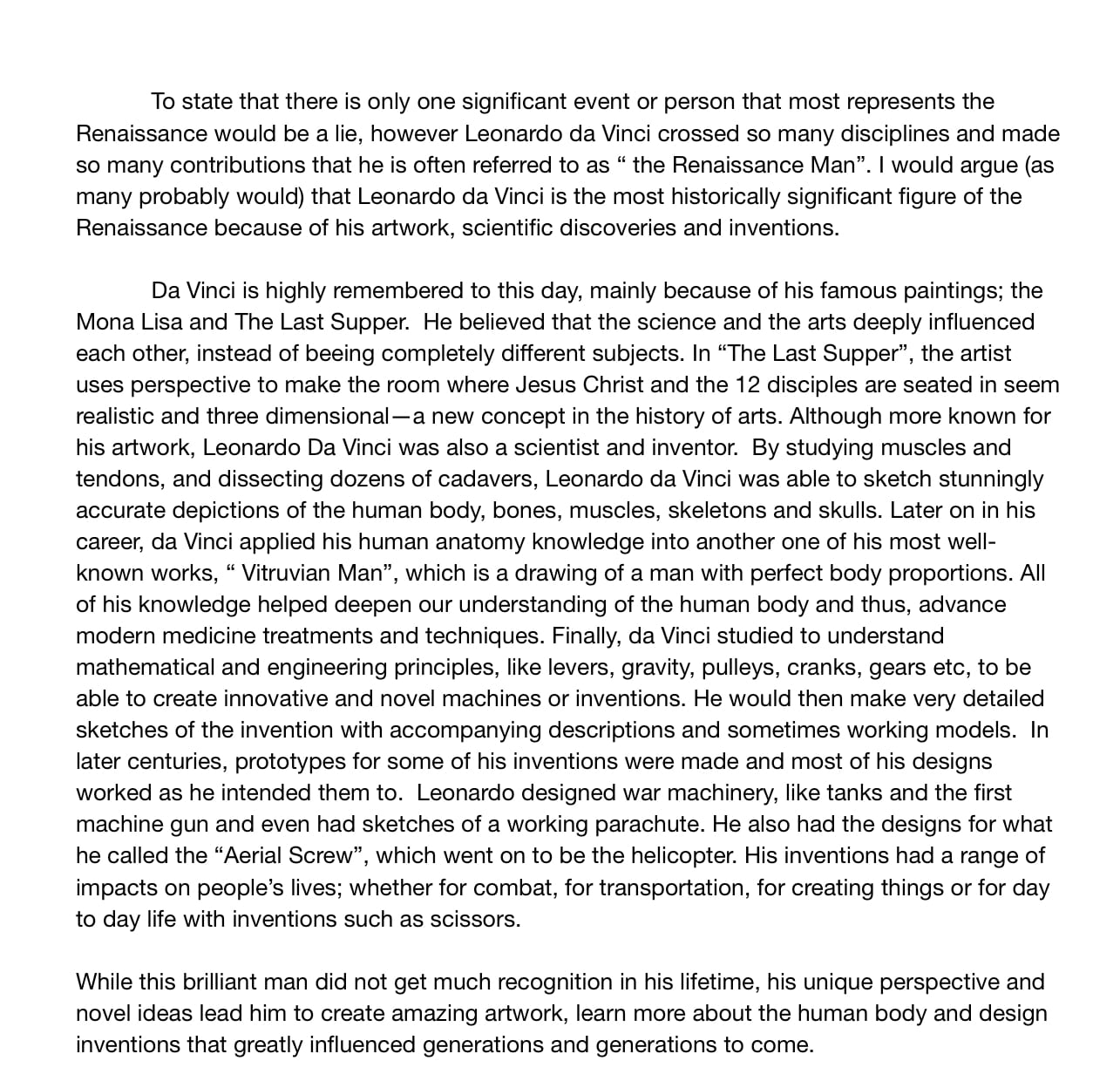Hello readers! Welcome back to my awesome blog! This post tells the story of my learning through our most recent Humanities project on the Renaissance and some of it’s everlasting effects on the world today. Don’t know too much about the Renaissance? Follow along and you might learn something you hadn’t known before on the way.
Historical Significance
When someone says the word “ history ’’, I tend to think of old things, events, people and civilizations. I also think of some specific important events that happened in the past that I’ve learnt or done a project on in school. There are way too many events in the past to possibly remember everything that happened centuries ago, so we must determine what is worth remembering. So how do we decide what’s worth remembering? Their are four criteria to help us determine historical significance in the past. The four criteria can be remembered using the acronym “NAME”.
N- Novelty
A- Applicability
M- Memory
E- Effect
As a class, we practiced multiple times filling out “NAME” charts to help us make a decision as to if something is historically significant using the four criteria. We were actually introduced to this helpful acronym on the Loon Lake learning advance. This was one of the most necassary building blocks toward our final two products for this project, which were going to be a well structured paragraph and a digital triptych. We then had to learn the definitions of the four criteria in our acronym. Below is a short description of each term and an example of a historic event.

Here is one of my first fully completed “NAME” charts on “ the printing press ”. Name charts helped us dive deeper into our research on a specific event, person or idea, making us question if it was very important at the time and if it lead to greater things in years to come.

Learning more about the Renaissance
Now that we knew how to determine if something was historically significant or not, it was time to put our knowledge to the test! Not a quiz or a multiple choice test, but proving our understanding in our research on the Renaissance. So what was the Renaissance? The Renaissance, was a period of time in European history lasting from the 14th to the 17th century. The word “renaissance” is a french word for “rebirth”, signifying how it was a time of great change not only in art but in culture, science, religion. So many inventions and innovations were made in this era.
We now understand the general concepts and influential movements of the Renaissance, so it was time to get specific with our research. It was now time for every student to learn more about one invention, one person, one societal change and one piece of artwork from the Renaissance. You could choose from the research bank below ⬇️ or suggest a different option to the teachers.

I chose the printing press, Leonardo da Vinci, the protestant reformation and the Creation of Adam. It’s crazy how much innovative things happened in the same period of time. My research on each of these topics was thorough and I completed a “NAME” chart on each one, because I knew it would come in handy when writing my final historical significance paragraph on one of these four chosen subjects.
Now let’s learn more about the other half of the final product, which was the triptych!
Making my triptych
We were going to be making our triptychs on an app called SuperimposeX, which is a developed photo editing app. I was first introduced to editing photos on this app at Loon Lake. My definition of a triptych is : a picture separated into 3 sections with 2 vertical lines, almost like a trifold. At first, I was pretty bad at using superimpose, because my masking wasn’t very good, but you can do so much more than masking!
As a class, the teacher’s guided us through some editing features in the app, I practiced and got somewhat better. My best photo editing skills kicked in closer to the triptych deadline though. In the triptych, you had to showcase the four historically significant developments you had researched on the outside panels, and then a picture or Memoji of yourself, with the contemporary version of the development or it’s impact on today.
I am very happy with my final Renaissance triptych. I continued making changes so that it looked less of a digital collage and more of a gallery, because that was what we were aiming for. My favourite parts of my triptych are the fact that I put the creation of Adam painting on the ceiling, because it’s actually a fresco in the Sistine Chapel. Admire it in all it’s beauty and detail:

I came to a decision to do my final paragraph on Leonardo da Vinci because of his numerous achievements throughout his life. Don’t know about you, but he sure make us all feel like under-achievers. Please take the time to read my paragraph on Leonardo da Vinci.
Overall, this has been an awesome project, because it combined history with photo editing and creativity and made me think about how much the past has affected who we are, and the world around us. Imagine going back in time to the Renaissance and showing the people our iPhones or iPads? They’d be blown out of their minds, they’d probably think we were aliens, but then again, there wouldn’t be Wifi. This project has made me realize how some of the Renaissance events and developments transfer to 2022, and that was the goal of this project.
Thanks for reading to the end of this post! I’d love to hear what you think about my final paragraph or triptych in the comments!
Bye!